![]()
![]()
![]()
Use LEFT and RIGHT arrow keys to navigate between flashcards;
Use UP and DOWN arrow keys to flip the card;
H to show hint;
A reads text to speech;
102 Cards in this Set
- Front
- Back
- 3rd side (hint)
|
Gene transfer by viruses |
-Transfer bacterial genes by bacteriophages -Virulent (lytic clycles) -Temperate |
|
|
|
Lytic vs lysogenic phage cycles hnotes |
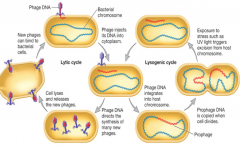
|
Lytic: when bacteriophages are replicated
lysogenic: when bacteriogene is replicated through mitosis prophage: when the genome has integrated with the host gene |
|
|
Generalized Transduction (during lytic cycle) |
-During lytic cycle -any part of the bacterial genome is transferred -During viral assembly, pieces of host DNA mistakenly packaged into phage (if done properly, lysis and injects into new cell) |
|
|
|
Specialized Transduction (during lysogenic cycle) |
-specific part of genome is transferred -its called specialized because it only replicates specific DNA that is adjacent to the prophase area along with its own - |
|
|
|
Hierarchical Arrangement in Taxonomy hpic |
•Phylum – group sharing a common ancestor •Genus – well defined group of one or more strains •Microbes are named using binomial system |

|
|
|
Well-studied phyla |
–Deinococcus-Thermus –Cyanobacteria –Chlamydiae –Spirochaetes –Bacteroidetes –Proteobacteria –Fermicutes –Actinobacteria |
|
|
|
Phylum Deinococcus-Thermus hpic |
•Can grow at high temperatures •Thermus aquaticus –70-75C –Source of Taq polymerase for PCR •Deinococcus radiodurans –Not thermophilic, but extremely resistant to radiation and desiccation –Rapid DNA repair |
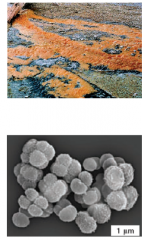
|
|
|
Phylum Cyanobacteria hpic |
•Primary producers in many ecosystems |
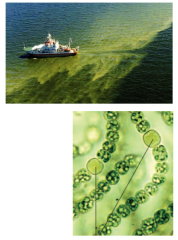
|
|
|
Phylum Cyanobacteria cont hpic heterocysts and 2way feeding |

-Genus: Anabaena -Gram negative: its acquatic -Both able to do oxygenic photosynthesis and N fixation (N2 0> ammonia) -problem: enzyme nitrogenase for N fixation is very sensitive to O2 -solution: differentiate vegetative cells, and develops a new cell type known as Heterocysts
|
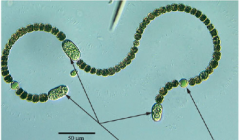
|
|
|
Phylum Chlamydiae hpic |
- Genus: Chlamydia -Gram negative, obligate intracellular bacteria - affects both human and animal pathogens (C.trachomatis causes #1 reported STD in US) has unique developmental cycle |
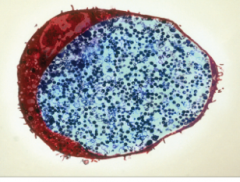
|
|
|
Chlamydia Development hpic |
Elementary body (EB): dormant, infectious, attaches and enters and develops into reticulate body: reproductive, non-infectious, develops back into body by cellular lysis |

|
|
|
Phylum Spirochaetes hpic |
•Pathogens •Treponema pallidum -Syphillus •Borrelia burgdorferi - Lyme disease (ticks) flexible in helical shape, flagella with periplasm |
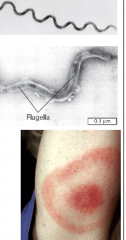
|
|
|
Phylum Bacteroidetes hpic |
•Obligate anaerobes •Genus: Bacteroides –Major flora of human colon –Degrade complex, dietary polysaccharides –May enter body tissues through wounds, causing abscesses |
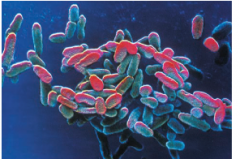
|
|
|
Phylum Proteobacteria (Gram Negatives) |
•Largest group –Five major classes (Alpha, Beta, Gamma, Delta, and Epsilon) •Diverse cell forms and metabolism –Heterotrophs –Phototrophs –Lithotrophs |
|
|
|
Phylum Proteobacteria (Gram Negatives) |
•Largest group –Five major classes (Alpha, Beta, Gamma, Delta, and Epsilon) •Diverse cell forms and metabolism –Heterotrophs –Phototrophs –Lithotrophs |
|
|
|
Alpha Proteobacteria hpic |
-caulibacter -gram - acquatic, asymmetric swimmer cell. asymmetric cell division generates a motile swarmer cell, and a non-motile stalked cell. |
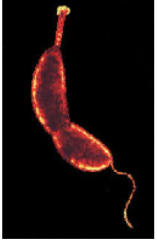
|
|
|
Caulobacter Life Cycle hpic |
1)cant replicate DNA 2) lose flagella 3) can replicate DNA now |

|
|
|
Beta Proteobacteria hpic |
•Lithotrophs •Nitrate, sulfur, iron oxidizers •Nitrification •Pathogens –Neisseria meningitidis and gonorrhoeae (shown on hpic)
|
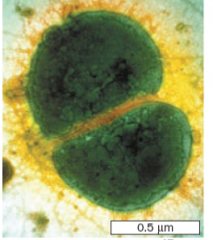
Features: gram negative diplococcus |
|
|
Gamma Proteobacteria |
•Family Enterobacteriaceae “Enterics” (intestine, live in the intestinal tract) •Facultative anaerobes (prefer oxygen, but can live w/o it), often motile rods •Escherichia coli –some strains are normal inhabitants of intestine, others pathogenic (0157:H7) • Salmonella- food poisoning • Proteus - urinary tract infections (swarming motility) Also includes NON-enterics - Pseudomonas aeruginosa opportunistic pathogen, takes advantage of host weakness) - Infects, lung, skin, eye, ear, burn wounds -pseudomonas fluorescens |
|
|
|
What is Zequanox? (gamma proteobacteria) |
-Marine biology innovations announces successful results of a zequanox treatment at christmas lake in shorewood. -Dead cells of P. fluorescens -mussels consume bacteria, but after ingested is destroyed, digestive lining is broken, death |
|
|

Delta Proteobacteria hpic (genus Bdellovibrio, parasiteizes other bacteria, grows in periplasm, lyses host) |
•Genus:Myxococcus •Gram - , social, soil bacteria •Attack other bacteria in “packs”kill and destroy •Gliding motility (no flagella) •Nutrient limiting conditions, cells assemble into fruiting bodies –with dormant myxospores |
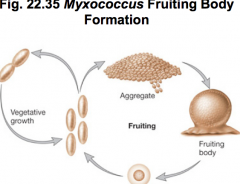
|
|
|
Epsilon Proteobacteria hpic |
smallest group of proteobacteria - Helicobacter pylori (the hpic) -Causes stomach ulcers (not a lot of microbes in stomach, can survive in that acidic area) -burrows below protective mucous layer in stomach - Class 1 carcinogen |
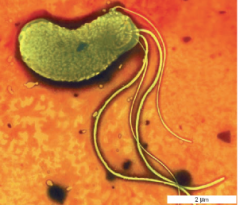
|
|
|
Phylum Firmicutes (Low G+C Gram+) hpic |
-includes pathogens -staphylococcus (MRSA) -Streptococcus -Also (good)bacteria "Lactobacillus, Lactococcus" -Fermentation produce lactic Acid -probiotics, cheese, yogurt |
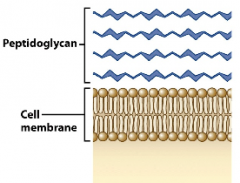
|
|
|
Phylum Firmicutes:Spore Formers hpic |
•Spores heat-resistant •Many also produce exotoxins -2 major genera -(clositridium) and (tetani) -botulinum: produces neurotoxin "botox" -difficle: colitis
-Bacillus, anthracis -thuringiensis (kills insects, used in Bt corn) |

|
|
|
Phylum Actinobacteria (High G+C Gram +) hpic |
Specifies bacteria with high Guanine or Cytosine count in DNA -Genus: mycobacterium -Species: tuberculosis and leprae -Acid-fast cell walls - Waxy Lipids (impervious to gram stains) -Streptomyces: source of many antibiotics
|
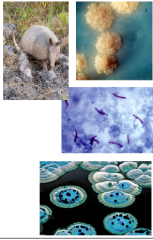
|
|
|
Eukaryotic Microorganisms |
•prominent members of ecosystems •useful as model systems and in industry •some are human and plant pathogens –among the 20 most frequent microbial causes of death world-wide, 6 are eukaryotic •two groups: Protists and Fungi |
|
|
|
Common Features of Eukaryotic Cells |
-capable of both sexual and asexual reproduction -asexual: binary fission or budding -sexual reproduction: cells called gametes fuse to form a diploid (zygote) -Meiosis and mitosis -membrane-bound nucleus -Plasma membranes (lipid bilayers) -Many have cell walls -membrane-enclosed organelles |
|
|
|
Organelles of Eukaryotic Cells |
-ER: endoplasmic reticulum (has the ribosomes, site of protein synthesis -Golgi apparatus: where proteins are modified, packaging and secretion -Mitochondria: powerhouse of the cell, synthesis of ATP via e transport and oxidative phosphorylation (proton motive force) also the site of the TCA cycle |
|
|
|
Protists - General Features |
•Domain –Eukarya •>60,000 different life forms •mostly unicellular •algae, slime molds, protozoa –protozoa - chemoorganotrophic –algae – photosynthetic |
|
|
|
Importance of Protists |
•important link in food chains –Plankton in aquatic habitats –Radiolarians, Diatoms and Foraminiferans •silica, calcium carbonate walls •reef formation, beach sand, limestone |
|
|
|
Protists - General Features |
•Terrestrial or aquatic •Some parasitic in humans, animals and plants •motile (they move) cilia, flagella, or pseudopodia (fake feet) • Reproduction: sexual and/or asexual
|
|
|
|
Organelles |
•Nuclei (1, 2 or more) •ciliates are protists with 2 distinct types of nucleu •micronucleus: true nucleus (from mitosis) • macronucleus: thousands of short linear chromosomes, genes for growth.
|
|
|
|
Vacuoles hpic |
• Contractile: osmoregulatory, expels water. (can stretch itself) • Phagocytic: engulfs food • Encystment: development into dormant stage (cyst) type of protection, and transmission •Excystment:– escape from cyst to metabolically active, motile form - trophozoite |
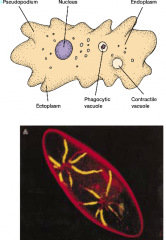
|
|
|
Metabolism and Nutrition |
•Metabolism –can be photosynthetic (oxygenic) –also chemoorganoheterotrophs and mixotrophs (organic and inorganic) •Nutrition –solid nutrients by phagocytosis –soluble nutrients by facilitated diffusion and active transport -holozoic nutrition: engulfing bacterial cells via phagocytosis |
|
|
|
Nutrition- Phagocytosis hpic |
1) pseudopodia: surrounds food, extend out 2) phagosome: the dome around food 3) lysosome: digestive enzymes. phagosome fuzes with lysosome (aka phagolysosome) 4&5) nutrients diffuse into cytoplasm, waste is released |
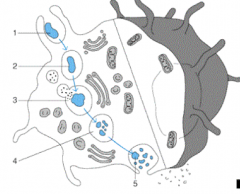
|
|
|
Representative Protists |
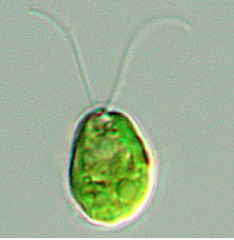
Chlamydomonas: not chlamydia, not pathogenic -its photosynthetic, single-celled green alga -wall of cellulose, motile -stigma (eyespot) role in phototaxis, filled with photoreceptors, moves in response to light. (goes towards light) -Sexual and asexual |
|
|
|
Cellular slime molds |

|
|
|
|
Giardia hnotes |

|
-Protozoan parasite -Human pathogen -Cysts ingested -Trophozoites attach to intestine -disrupts nutrient, H20 flow -Animal reservoirs, human carriers |
|
|
The Alveolata hpic |
•Includes the Dinoflagellates ,Ciliates and Apicomplexans •Trichocysts: a protein in dinoflagellates that shoot out as a means of defense. •Zooxanthellae: motile dinoflagellates that are symbiotic with coral reefs (redtides) |
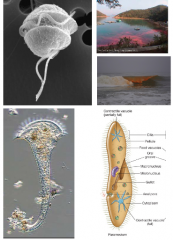
|
|
|
Apicomplexans are important causes of human disease (MEMORIZE) and hpic |
•Cryptosporidiosis (oocysts ingested, small chlorine resistant and stable) excystment to become trophozoites in intestines, transmitted in water and animals –Cryptosporidium • Toxoplasmosis (oocysts from raw/undercooked meat or cat poop) ingested oocysts become tachyzoites and live in neural/muscle tissue, can cross placenta –Toxoplasma •Malaria –Plasmodium falciparum |
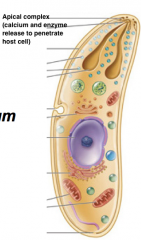
|
|
|
Malaria hpic |
-caused by 4 species of plasmodium (memorize genus plasmodium falciparum) -transmitted by bite of infected female Anopheles mosquito -sporozoite form of plasmodium in hpic 300million cases/year |
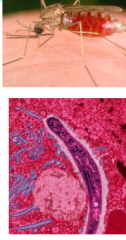
|
|
|
Malaria cycle |
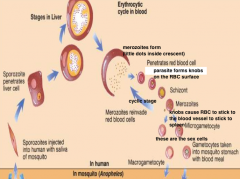
|
|
|
|
Malaria - Clinical |
•periodic chills, fever •anemia •liver, spleen - hypertrophy |
|
|
|
Malaria - Control, Prevention, Treatment (memorize) |
•Mosquito control - wetland drainage, insecticides, bed netting -drugs: chloroquine (parasite degrades hemoglobin as nutrient and releases toxic heme protein) parasite polymerizes into non-toxic form. So chloroquine blocks the polymerization so that toxic heme remains to kill parasite -drug: malarone( blocks e-transport and pyrimidine synthesis) |
|
|
|
Fungi basics |
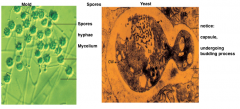
|
|
|
|
Fungi General features |
Domain Eukarya Kingdom: Fungi -Monophyletic -size: single celled yeast to 3mile wide honey mushroom - lack chlorophyll - have plasma membranes -cell walls of chitin (polymer of N-acetylglucosamine) same as shrimp and lobster -Nutrition: are saprophytes (eat dead matter) and are absorptive (secrete enzymes and absorb it back) |
|
|
|
Fungi: The Great Decomposers |
•able to break down many complex organic compounds including cellulose •without fungi, dead plants and trees would accumulate to great depths •without fungal activity and resulting CO2 production - plant, and ultimately human life would cease |
|
|
|
Some terms |
-Mycology: study of fungi -Mycoses: diseases caused by fungi -mycotoxicosis: poisoning due to fungal tosin (aflatoxins: intercalate into DNA, are carcinogens) (ergot alkaloids: causes delusions and convulsions) |
|
|
|
Fungi: Distribution (where do we find them) |
Mostly terrestrial •Can be part of human microflora •Can be pathogens •Can form associations •Lichens = fungi + cyanobacteria(photosynthetic) •Mycorrhizal fungi -with plant roots (mutualism)
|
|
|
|
Fungi facts hnotes |
Yeast: unicellular fungi -Saccharomyces cerevisiae: in bread, beer, and wine -Candida albicans: found in mouth, vagina, and intestinal tract |
easts in bread • Ferment sugars in flour or added to dough • Releases CO 2 and ethanol, CO 2 trapped in bubbles, results in dough expanding or rising. • Sourdough uses yeast in symbiosis with bacteria of the genus Lactobacillus. • Yeasts in wine • Ferment sugars in grape juice producing CO 2 and ethanol • Naturally occuring yeasts or modern methods of isolation and maintenance • One yeast cell can ferment its own weight of glucose/ hr , producing 15-18% by volume ethanol. |
|
|
Fungi: Asexual reproduction hpic |
-offspring genetically identical -3 mechanism: binary fission, budding, and spore production -conidiospores, and sporangiospores |

|
|
|
Fungi: sexual reproduction hpic |
•Often under stress or limiting nutrients •Offspring genetically intermediate •Haploid cells of opposite mating types fuse, create diploid –Pheromones signal between types •Yeast–Mating types: a and alpha (α) •Fungi–Hyphae meet and fuse (in mold form cross out fungi) |
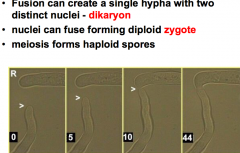
|
|
|
Rhizopus Sexual and Asexual Stages hnotes |
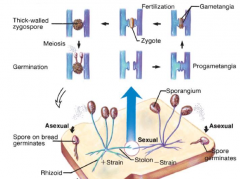
|
budding, binary fission, spores
zygospores: spores generated via sexual reproduction sporangium: spores generated via asexual reproduction |
|
|
Fungal Divisions |
•18S rRNA analysis groups fungi into 8 subdivisions •Four of the better known subdivisions: –Chytridiomycota –Zygomycota –Ascomycota –Basidiomycota |
|
|
|
Chytridiomycota hpic |
-Simplest of the fungi (intermediate of protists and fungi) -aquatic -motile flagellated zoospore (zoospores usually are motile) Disease: chytridiomycosis-responsible for massive # of frogs by infecting the skin of the frogs |
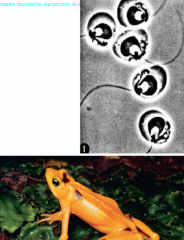
|
|
|
Zygomycota |
•Capable of both Sexual zygospores, and asexual sporangiospores •Example: bread -Rhizopus: bread mold, rice seedling blight, meat tenderizer, birth control agents |

|
|
|
Ascomycota |
-make sac fungi called ascus. -capable of sexual reproduction called ascospores, and asexual reproduction called conidiospores •Examples: •Saccharomyces, Aspergillus, Penicillium -Geomyces: causes white nose syndrome in bats, psychrophile |
|
|
|
Basidiomycota hnotes |
-club fungi -Basidium: structure that bears sexual basidiospores examples: mushrooms, cryptococcus neoformans Genus: Amanita= includes death angel -amanitin- peptide toxin that targets RNA polymerase and kills it |
Cryptococcus neoformans: pathogen in AIDS and otehr immunocompromise patients: basidiospores are inhaled, infects lung and central nervous system (can pass the blood/brain barrier) |
|
|
Ecology and Environmental Microbiology |
Study behavior and activities of microbes in their environments. Microbes are found in every environment on earth, and are integral to the biogeochemical cycles that shape the environment of earth and its oceans. Elements flow in cycles, all nutrient cycles are linked and make life on earth possible |
|
|
|
Carbon Cycling hpic |
CO2 and methane are greenhouse gases that trap heat in earths atmosphere oxidized forms of Carbon (CO and CO2) reduced forms: organic matter(glucose), methane photosynthesis fixes CO2 into biomass, microbes fix 1/2 of the worlds carbon produces O2 and organic compounds Compounds oxidized back to CO2 by respiration = glycolysis + TCA + ETC |
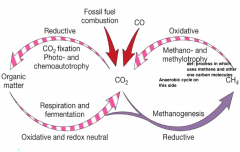
|
|
|
Anaerobic Carbon Cycling hnotes |
methanogens These are anaerobic archaea They are gaining energy by reducing CO2 to CH4 makes about 1 billion tons of methane/yr some live in symbiosis with termites. Cows also constantly produce methane, Ruminants (animals that have rumin in their stomachs that make methane) |
Methanotrophs: aerobic, anaeorobic archaea and bacteria methane is used as C course to convert to CO2 |
|
|
The Nitrogen Cycle hpic |
There are processes that change these
NO3 --> N2 is dentrification N2 --> NH4 nitrification |
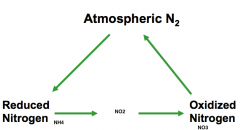
|
|
|
Microbial Symbiosis hpic |
•Symbioses –Association of two or more organisms •Physical associations –Ectosymbiont - organism on another –Endosymbiont - organism in another •Symbiotic relationships between microbes and multicellular organisms are a major feature of life on earth |
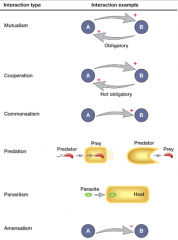
|
|

Amensalism |
Antibiotic production by bacteria and fungi |
|
|

Parasitism – one benefits, other harmed (coexist) hpic(memorize) |
Some viruses and cells fit this category. Agrobacterium and plants show this relationship: - causes crown gall disease -has tumor-inducing plasmid called (TI) -Piece of TI is transferred into the plant cell -piece integrates into plant genome |
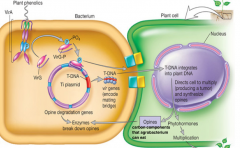
|
|

Predation – one benefits, other harmed |
•Bdellovibrio –bacterial predator of other bacteria (uses flagella and rams into prey bacteria) •Myxococcus – “wolf packs” prey on other bacteria |
|
|

Commensalism - one benefits, other neutral hpic |
example: skin or surface microbes on plants or animals.
|
|
|
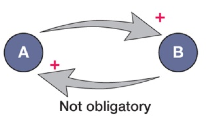
Cooperation: not obligatory |
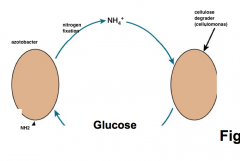
|
|
|
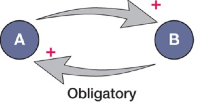
Mutualism - both benefit (obligatory |
•Photosynthetic algae (Protists) and coral •Tube worms and bacteria •Vibrio and squid |
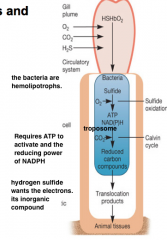
|
|
|
Mutualism continued (KEY TERM) |
Most corals obtain energy and nutrients from Zooxanthellae that live within the coral's tissue. Zooxantheliae: photosynthetic algae that are dinoflagellates |
|
|
|
Mutualism: photosynthetic Algae and coral |
Zooxantheliae: are dinoflagellates that Energy fixes CO2 into carbohydrates. this goes to Coral Coral Fixes nitrogen, phosphate, and CO2 and sends it back to the zooxantheliae. This process is called coral bleaching.
|
|
|
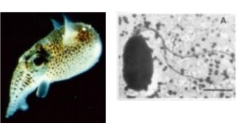
Squid-Bacterial Relationship hnotes |
Bacteria in the light organ makes the light from the bobtail squid- are luminescent b/c of luciferase Vibrio fischeri- uses quorum sensing to control light production; cells produce light only if they are at a high density |
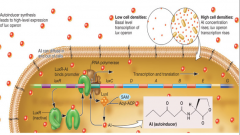
Signaling molecule (autoinducer) produced by the microbe and auto-induces the microbe. (vibrio produces acyl homoserine lactone) when it reaches a critical level, genes get turned on. LuxR(protein) a transcription factor that will bind to a promotor that controls an operon. Lux operon encodes for the gene luciferase. |
|
|
Some Relationships are Complicated |
Tropical panic grass: grows in soils that are heated (high temps) has a fungus in symbiotic relationship. If fungus is lost, loses the heat resistance. The fungus has a virus inside it. If you remove the virus from the fungus, and it loses the heat resistance. |
|
|
|
Immunology |
•Immune system –widely distributed cells, tissues, organs –recognizes foreign substances, neutralizes or destroys –antigens - foreign substances that provoke immune response –antibodies- bind antigens, inactivate or eliminate •Immunity – ability to resist disease or infection •Immunology – studies how body defends against foreign invaders, harmful substances |
|
|
|
The Immune System Protects Against Four Classes of Pathogen |
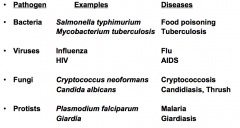
|
Immune System Also Participates in Disease •Allergy •Autoimmunity •Transplantation (Tissue) Rejection •Graft-vs-Host Disease |
|
|
Types of Immune Responses |
Innate immunity: -non-specific:first line of defence -fast acting, no memory of prior infectiosn -cell: macrophages, neutrophils, dendritic -components: anatomical features (skin), complement(series of protein in seron), toll-like receptors, cytokines |
|
|
|
Cells of the Immune Response |
•Leukocytes (white blood cells) –Function in both innate and adaptive immune responses –From pluripotent stem cells in bone marrow –5 major types •Neutrophils, Basophils, Eosinophils, Monocytes, Lymphocytes |
|
|
|
Macrophages (amoeba) |
•derive from monocytes in blood •Enter, reside in tissue (motile) •3 major functions
Phagocytic: engulf and destroy with reactive oxygen and nitrogen species. examples: hydrogen peroxide and nitric oxide. Antigen presentation, makes cytokines and chemokines |
|
|
|
Neutrophils also called Polymorphonuclear leukocytes (PMNs) |
•stain at neutral pH •circulate in blood, migrate to infection sites •functions similar to macrophages -a source of defensins (antimicrobial peptides) helps kill invaders |
|
|
|
Dendritic Cells |
•can also derive from monocytes •in blood, skin, mucous membranes •phagocytic •migrate to lymph nodes - present antigens to lymphocytes (take antigens from one site, and takes them to place where they are needed) |
|
|
|
Innate Immune Response: Components |
•Anatomical features •Complement •Toll-like receptors •Cytokines |
|
|
|
Barriers to Pathogen Entry Into the Body |
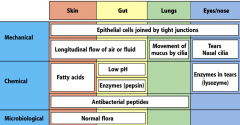
|
|
|
|
The Complement System |
•>30 serum proteins •activated by enzymatic cleavage • “complements”activity of antibody Functions: -opsonins: coat microbes for phagocytosis (ex: C3b) -chemotactic factors: PMN migration from blood to infection (ex: C5a) -membrane atk complex |
|
|
|
Toll-Like Receptors (TLRs) |
•Pattern recognition receptors on phagocytes, at least 10 distinct receptors in family -at least 10 distinct receptors in this family -bind pathogen-associated molecular patterns (PAMPs) -examples of PAMPs: TLR4, LPS, TLR2 recogizes peptidoglycan, TLR3 recognizes doublestranded RNA |

|
|
|
Cytokines and Chemokines |
•Protein signaling molecules •Interleukins (IL) – stimulate cell growth, differentiation, proliferation •Tumor Necrosis Factor (TNF) – increases vascular permeability (macrophages can squeeze into the tissues), fever, activates B and T cells -Chemokines: cytokines that stimulate cell migration to infection sites -Interferons: cytokines that are produced in response to viruses(they block viral replication and assembly) -Endogenous pyrogens: cytokines that induce fever (Tumor necrosis factor, TNF) circulate to hypothalamus-> induce neurons to make prostaglandins -> fever |

|
|
|
Adaptive (Specific) Immune Response |
-Discriminates between self and non-self -has specificity and memory (can recognize between memory Tcells and Bcells) -slower than innate during primary infection (takes more time to heal, but will defend long term) -components: antibodies, antigen receptors, major histocompatibility complex(MHC) -main cells that do this, B-cells and T-cells (B cells matures in bone marrow, and Tcells mature in the thymus, but both produced in bone marrow) |
|
|
|
Adaptive Immunity Has Two Branches |
•Humoral:defends against extracellular pathogens –involves antibodies (made by B cells) •Cell-Mediated (deals with intercellular pathogens) –involves T cells |
|
|
|
While innate immune responses are often initiated at sites of infection, adaptive immune responses are often initiated in lymphoid organs and tissues. |
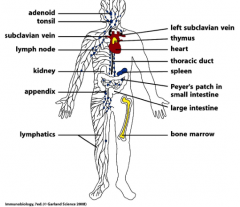
-primary: where lymphocytes mature (b&tcells), bone marrow and thymus Secondary: where lymphocytes engage antigen,(place of infections) |
|
|
|
B-Cells hpic |
-Make antibodies and put them on the surface of cell (use them as receptors) -are antigen-presenting cells (APC) like macrophages that break down the pathogen -Are activated by antigen and/or Tcells -develops into plasma cells: produce and secrete antibodies. also develop in memory cells: remember the pathogen for future defense rapid response |
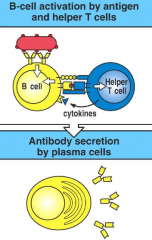
|
|
|
Antibodies (Immunoglobulin) |
MADE BY B-Cells •Defend against extracellular pathogens •Attached to B cell surface or free in blood and tissues •Bind antigens - neutralize or opsonize (they can promote the engulfment of the pathogen by the macrophage) -Affinity: the strength with which the antibody binds with the antigen. -Epitopes: parts of an antigen that antibodies bind -one antigen can have several epitopes, each can bind with a different antibody. -5 Classes: IgM, IgC, IgA, IgE, IgD (Ig = immuno-globulin) IgG is major one in serum, IgA is a secretory Ig found in secretions and mucus, also breast milk. |
|
|
|
Antibody Structure (IgG structure) |
(look at sheet of paper with picture) has 2 light and 2 heavy chain. Heavy and light chain are connected by di-sulfide bonds. also connects the two heavy chains together. Fc = crystalizable fragment The bottom is where it connects to antibody. the variable region of the heavy and light chain is where the antigen binding site is. (two different ones)
|
|
|
|
From birth, our naive immune system is
able to recognize millions of possible
foreign antigens. How is this possible? How is antibody diversity generated? |
-Major mechanism: rearrangement of antibody gene segments.
|
|
|
|
Formation of a gene for the heavy chain of an antibody - VDJ Joining hnotes |
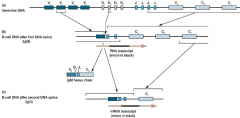
|
This happens at the light chain too. Basically at random cut and splice the genes together to form the chain. RNA transcription makes it happen. Then mRNA transcript forms IgG heavy chain |
|
|
Clonal Selection: VDJ joining occurs as Bcells develop in bone marrow, (prior to infection) |
•Generates vast array of B cells, each preprogrammed to bind a specific antigen •B cells travel to lymphoid organs and tissues •Upon infection, antigen “selects” B cell with antibody that matches it •B cell proliferates, forming clone of identical cells, each with antibody for the antigen
|
|
|
|
Clonal Selection: 1st box)Random antibody gene rearrangement 2nd box)Tolerance - Clonal deletion remoevs B cells that recognize self antigens |
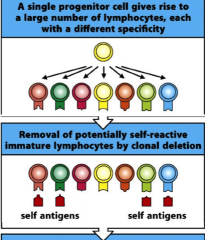
|
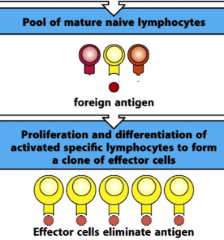
|
|
|
Adaptive Immunity Has Specificity and Memory |
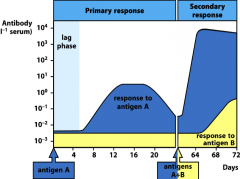
|
|
|
|
T-Cells Hnotes (important!) |
•Activated when their receptors bind antigens presented by cells (2 types) •Helper Tcells: make cytokines, activate Bcells to make antibody or macrophages to phagocytose •Cytotoxic Tcells: kill cells expressing foreign antigens, makes perforins (form pores in the membrane of infected cell) and granzymes (induce apoptosis: programmed cell death) • |
In addition to specific receptors, immune cells have other membrane proteins called Cluster of Differentiation (CD) molecules that can function as co-receptors. CD molecules can also be used to determine a cell’s identity -Helper Tcells have CD4 -Cytotoxic Tcells have CD8 |
|
|
T-Cell Receptors (TCRs) hpic |
•T cell receptors bind antigens (usually peptides) presented to them by other cells • but only when presented by a Major Histocompatibility Complex (MHC) molecule |
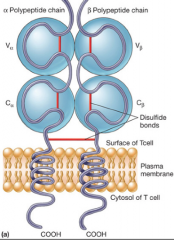
|
|
|
The Major Histocompatibility Complex (MHC) is a collection of genes encoding cell surface molecules for self/nonself recognition |
•In humans called Human Leukocyte Antigen (HLA) complex •You have 2 sets of MHC genes - one from each parent - both are expressed •Closer 2 people related, more similar their HLAs, important in donor selection for tissue, bone marrow and organ transplant |
|
|
|
Cell Surface Molecules Encoded By MHC Are Designated Class I and Class II |
Class I MHC: found on all nucleated cells (basically all cells except RBC) Class II MHC: Only found on antigen-presenting cells (ex dendritic cells, macrophages, B-cells) |
|
|
|
Class I and II molecules inform the immune system of the presence of nonself (a microbial pathogen) by binding and presenting foreign peptides |
Class I MHC •present peptides that originate in the cytoplasm from intracellular pathogens -Present peptides to CD8+ cytotoxic Tcells Class II MHC •present peptides from extracellular pathogens, taken up and broken down by phagocytosis |
|
|
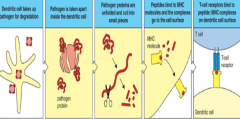
|
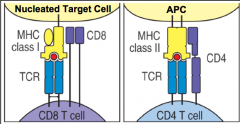
Tcells release granzymes, perforins. Target cell with intracellular pathogen is killed. |
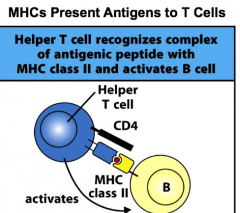
|

